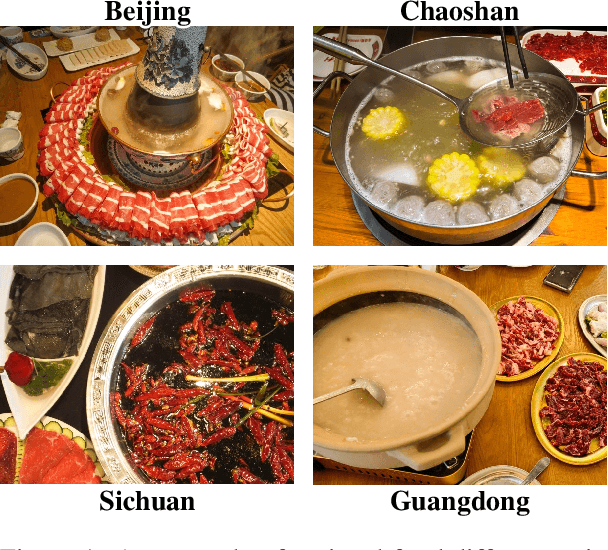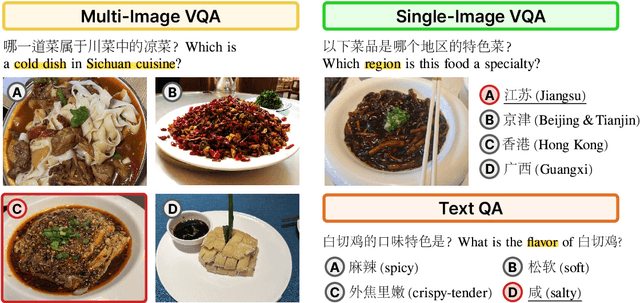Jiaang Li
Cultural Evaluations of Vision-Language Models Have a Lot to Learn from Cultural Theory
May 28, 2025Abstract:Modern vision-language models (VLMs) often fail at cultural competency evaluations and benchmarks. Given the diversity of applications built upon VLMs, there is renewed interest in understanding how they encode cultural nuances. While individual aspects of this problem have been studied, we still lack a comprehensive framework for systematically identifying and annotating the nuanced cultural dimensions present in images for VLMs. This position paper argues that foundational methodologies from visual culture studies (cultural studies, semiotics, and visual studies) are necessary for cultural analysis of images. Building upon this review, we propose a set of five frameworks, corresponding to cultural dimensions, that must be considered for a more complete analysis of the cultural competencies of VLMs.
RAVENEA: A Benchmark for Multimodal Retrieval-Augmented Visual Culture Understanding
May 20, 2025Abstract:As vision-language models (VLMs) become increasingly integrated into daily life, the need for accurate visual culture understanding is becoming critical. Yet, these models frequently fall short in interpreting cultural nuances effectively. Prior work has demonstrated the effectiveness of retrieval-augmented generation (RAG) in enhancing cultural understanding in text-only settings, while its application in multimodal scenarios remains underexplored. To bridge this gap, we introduce RAVENEA (Retrieval-Augmented Visual culturE uNdErstAnding), a new benchmark designed to advance visual culture understanding through retrieval, focusing on two tasks: culture-focused visual question answering (cVQA) and culture-informed image captioning (cIC). RAVENEA extends existing datasets by integrating over 10,000 Wikipedia documents curated and ranked by human annotators. With RAVENEA, we train and evaluate seven multimodal retrievers for each image query, and measure the downstream impact of retrieval-augmented inputs across fourteen state-of-the-art VLMs. Our results show that lightweight VLMs, when augmented with culture-aware retrieval, outperform their non-augmented counterparts (by at least 3.2% absolute on cVQA and 6.2% absolute on cIC). This highlights the value of retrieval-augmented methods and culturally inclusive benchmarks for multimodal understanding.
Enhance Lifelong Model Editing with Continuous Data-Adapter Association
Aug 19, 2024Abstract:Large language models (LLMs) require model editing to efficiently update specific knowledge within them and avoid factual errors. Most model editing methods are solely designed for single-time use and lead to a significant forgetting effect after sequential edits over time, referred to as lifelong editing. Current approaches manage sequential edits by freezing original parameters and allocating new adapters for each knowledge modification. However, these methods lack robustness to minor input variations. To address this challenge, we propose ELDER, \textbf{E}nhancing \textbf{L}ifelong mo\textbf{D}el \textbf{E}diting with mixtu\textbf{R}e of Low-Rank Adapter (LoRA). ELDER is an adaptive approach that integrates multiple LoRAs through a router network. It learns to create a continuous and smooth association between data and adapters, thereby enhancing robustness and generalization to semantically equivalent inputs. Additionally, we introduce a novel loss to help learn associations between adapter allocations and edit semantics. A deferral mechanism is also proposed to retain the original LLM capabilities post-edit. Extensive experiments on GPT-2 XL and LLaMA2-7B demonstrate that ELDER effectively edits models in the lifelong setting and exhibits strong scalability, while retaining LLM's general abilities on downstream tasks.
FoodieQA: A Multimodal Dataset for Fine-Grained Understanding of Chinese Food Culture
Jun 16, 2024



Abstract:Food is a rich and varied dimension of cultural heritage, crucial to both individuals and social groups. To bridge the gap in the literature on the often-overlooked regional diversity in this domain, we introduce FoodieQA, a manually curated, fine-grained image-text dataset capturing the intricate features of food cultures across various regions in China. We evaluate vision-language Models (VLMs) and large language models (LLMs) on newly collected, unseen food images and corresponding questions. FoodieQA comprises three multiple-choice question-answering tasks where models need to answer questions based on multiple images, a single image, and text-only descriptions, respectively. While LLMs excel at text-based question answering, surpassing human accuracy, the open-sourced VLMs still fall short by 41\% on multi-image and 21\% on single-image VQA tasks, although closed-weights models perform closer to human levels (within 10\%). Our findings highlight that understanding food and its cultural implications remains a challenging and under-explored direction.
Understanding Retrieval Robustness for Retrieval-Augmented Image Captioning
Jun 04, 2024



Abstract:Recent advancements in retrieval-augmented models for image captioning highlight the significance of retrieving related captions for efficient, lightweight models with strong domain-transfer capabilities. While these models demonstrate the success of retrieval augmentation, retrieval models are still far from perfect in practice. Retrieved information can sometimes mislead the model generation, negatively impacting performance. In this paper, we analyze the robustness of the SmallCap retrieval-augmented captioning model. Our analysis shows that SmallCap is sensitive to tokens that appear in the majority of the retrieved captions, and integrated gradients attribution shows that those tokens are likely copied into the final caption. Given these findings, we propose to train the model by sampling retrieved captions from more diverse sets. This reduces the probability that the model learns to copy majority tokens and improves both in-domain and cross-domain performance effectively.
Does Instruction Tuning Make LLMs More Consistent?
Apr 30, 2024



Abstract:The purpose of instruction tuning is enabling zero-shot performance, but instruction tuning has also been shown to improve chain-of-thought reasoning and value alignment (Si et al., 2023). Here we consider the impact on $\textit{consistency}$, i.e., the sensitivity of language models to small perturbations in the input. We compare 10 instruction-tuned LLaMA models to the original LLaMA-7b model and show that almost across-the-board they become more consistent, both in terms of their representations and their predictions in zero-shot and downstream tasks. We explain these improvements through mechanistic analyses of factual recall.
Word Order's Impacts: Insights from Reordering and Generation Analysis
Mar 18, 2024Abstract:Existing works have studied the impacts of the order of words within natural text. They usually analyze it by destroying the original order of words to create a scrambled sequence, and then comparing the models' performance between the original and scrambled sequences. The experimental results demonstrate marginal drops. Considering this findings, different hypothesis about word order is proposed, including ``the order of words is redundant with lexical semantics'', and ``models do not rely on word order''. In this paper, we revisit the aforementioned hypotheses by adding a order reconstruction perspective, and selecting datasets of different spectrum. Specifically, we first select four different datasets, and then design order reconstruction and continuing generation tasks. Empirical findings support that ChatGPT relies on word order to infer, but cannot support or negate the redundancy relations between word order lexical semantics.
Exploring Visual Culture Awareness in GPT-4V: A Comprehensive Probing
Feb 15, 2024Abstract:Pretrained large Vision-Language models have drawn considerable interest in recent years due to their remarkable performance. Despite considerable efforts to assess these models from diverse perspectives, the extent of visual cultural awareness in the state-of-the-art GPT-4V model remains unexplored. To tackle this gap, we extensively probed GPT-4V using the MaRVL benchmark dataset, aiming to investigate its capabilities and limitations in visual understanding with a focus on cultural aspects. Specifically, we introduced three visual related tasks, i.e. caption classification, pairwise captioning, and culture tag selection, to systematically delve into fine-grained visual cultural evaluation. Experimental results indicate that GPT-4V excels at identifying cultural concepts but still exhibits weaker performance in low-resource languages, such as Tamil and Swahili. Notably, through human evaluation, GPT-4V proves to be more culturally relevant in image captioning tasks than the original MaRVL human annotations, suggesting a promising solution for future visual cultural benchmark construction.
Random Entity Quantization for Parameter-Efficient Compositional Knowledge Graph Representation
Oct 24, 2023Abstract:Representation Learning on Knowledge Graphs (KGs) is essential for downstream tasks. The dominant approach, KG Embedding (KGE), represents entities with independent vectors and faces the scalability challenge. Recent studies propose an alternative way for parameter efficiency, which represents entities by composing entity-corresponding codewords matched from predefined small-scale codebooks. We refer to the process of obtaining corresponding codewords of each entity as entity quantization, for which previous works have designed complicated strategies. Surprisingly, this paper shows that simple random entity quantization can achieve similar results to current strategies. We analyze this phenomenon and reveal that entity codes, the quantization outcomes for expressing entities, have higher entropy at the code level and Jaccard distance at the codeword level under random entity quantization. Therefore, different entities become more easily distinguished, facilitating effective KG representation. The above results show that current quantization strategies are not critical for KG representation, and there is still room for improvement in entity distinguishability beyond current strategies. The code to reproduce our results is available at https://github.com/JiaangL/RandomQuantization.
Copyright Violations and Large Language Models
Oct 20, 2023Abstract:Language models may memorize more than just facts, including entire chunks of texts seen during training. Fair use exemptions to copyright laws typically allow for limited use of copyrighted material without permission from the copyright holder, but typically for extraction of information from copyrighted materials, rather than {\em verbatim} reproduction. This work explores the issue of copyright violations and large language models through the lens of verbatim memorization, focusing on possible redistribution of copyrighted text. We present experiments with a range of language models over a collection of popular books and coding problems, providing a conservative characterization of the extent to which language models can redistribute these materials. Overall, this research highlights the need for further examination and the potential impact on future developments in natural language processing to ensure adherence to copyright regulations. Code is at \url{https://github.com/coastalcph/CopyrightLLMs}.
 Add to Chrome
Add to Chrome Add to Firefox
Add to Firefox Add to Edge
Add to Edge